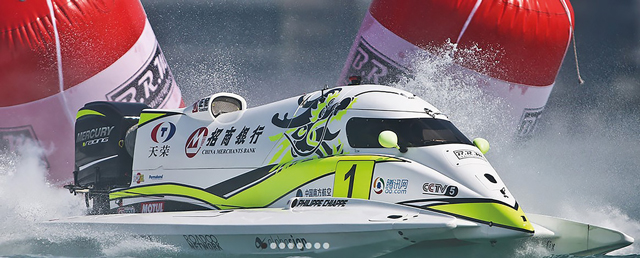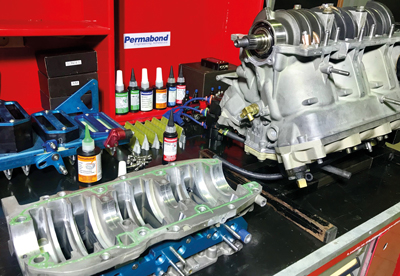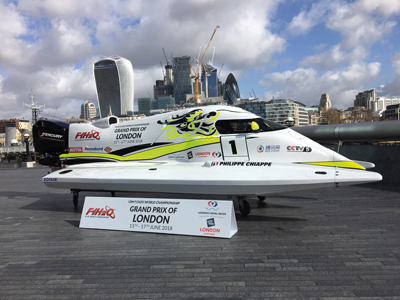
In maintaining competition powerboats, speed and convenience are vital. Permabond business development manager Daniela Davidson outlines the role of adhesives and sealants
For maintenance and repair, speed and convenience is crucial – and can be the difference between winning and losing. That was the brief from the F1H2O powerboat team, CTIC F1 Shenzhen China, when it approached Permabond Engineering Adhesives for help with its adhesive applications. its high-speed powerboat is competing in the British leg of the UIM F1H2O World Championship at East London’s Royal Victoria Dock in June.
Fast cure at room temperature, ease of dispensing and storage and high performance in bonding lightweight aluminium and composites were all vital in selecting the right adhesives for this mobile team of engineers. A wide variety of adhesives were selected for numerous maintenance and repair applications.
 Gasketing anaerobic adhesives are designed to replace traditional pre-formed cork, wood, rubber, paper and silicone gaskets. One adhesive replaces many pre-cut gasket shapes, simplifying gasket replacement on the hoof at various worldwide destinations without having to source the exact size and shape. Some traditional gaskets can be fragile, prone to relaxation, shrinkage, disintegration and embrittlement, resulting in leaks and blockages. Liquid gasket adhesives eliminate all these problems, protect against vibration and achieve 100% contact between metal parts, allowing better stress distribution and reduced machining time. They are also easy to dismantle.
Gasketing anaerobic adhesives are designed to replace traditional pre-formed cork, wood, rubber, paper and silicone gaskets. One adhesive replaces many pre-cut gasket shapes, simplifying gasket replacement on the hoof at various worldwide destinations without having to source the exact size and shape. Some traditional gaskets can be fragile, prone to relaxation, shrinkage, disintegration and embrittlement, resulting in leaks and blockages. Liquid gasket adhesives eliminate all these problems, protect against vibration and achieve 100% contact between metal parts, allowing better stress distribution and reduced machining time. They are also easy to dismantle.
Anaerobic retaining compounds are used to secure bearings, bushes and cylindrical parts to shafts or into housings.They are applied as a liquid, making assembly very quick and easy. The adhesive strength is often higher than alternative methods of fixture, offering increased load transmission capability and uniform stress distribution. Tolerances can be relaxed, reducing machining times and eliminating the need for interference fits. Having a better fatigue life, retaining compounds also prevent metal fretting, which can be an issue with interference fits.
Thread-locking anaerobic adhesives are used to lock and seal components such as screws, nuts, bolts and studs to protect against problems like vibration loosening, a major consideration for applications in a high-speed powerboat. They lubricate the thread for ease and speed of assembly, seal against leaks, prevent nuts from rusting on to bolts and allow machining tolerances to be increased. They are available in a range of bond strengths – low strength for large components requiring future disassembly, and medium strength and high strength permanent thread lockers, which in some applications may help to prevent theft and vandalism.
 Epoxy adhesives are a popular choice for high strength structural bonding of metals, composites, wood and some plastics. Their excellent chemical resistance makes them ideal for applications in harsh environments. Epoxies are available as two-part room temperature cure products, or single part heat cure (for ultimate strength, chemical and temperature resistance). Heat curing was not practical for the F1H2O team. Instead, they favoured room temperature cure epoxies, including a thermally conductive modified epoxy hybrid, offering flexibility and high temperature resistance.
Epoxy adhesives are a popular choice for high strength structural bonding of metals, composites, wood and some plastics. Their excellent chemical resistance makes them ideal for applications in harsh environments. Epoxies are available as two-part room temperature cure products, or single part heat cure (for ultimate strength, chemical and temperature resistance). Heat curing was not practical for the F1H2O team. Instead, they favoured room temperature cure epoxies, including a thermally conductive modified epoxy hybrid, offering flexibility and high temperature resistance.
Structural acrylic adhesives are high strength adhesives for bonding metals, composites, plastics, glass and wood. They resist tensile, peel, cleavage and impact forces and offer excellent durability and chemical resistance, making them suitable for exposure to oil, grease, moisture and weathering. They cure rapidly at room temperature and are available as two-part, 1:1 pre-mix systems dispensed through mixing nozzles, or as two-part, no-mix systems, where the resin is applied to one surface and initiator to the other. Cure is only activated when the two components are brought together, allowing time for adhesive application on larger parts. The F1H2O team chose a no-mix system for high strength aluminium repairs, achieving a working strength in 3-5 minutes.
Polyurethane adhesives are fast-setting structural adhesives, particularly well suited to bonding composites such as carbon fibre, GRP and FRP as well as rubber, leather, metals and plastics. They offer excellent impact resistance, high shear and peel strength and excellent resistance to harsh environments, making them ideal for lightweight composite body assembly and repair. A range of cure speeds makes them suitable for bonding and repair of large and small components.
The Union Internationale Motonautique F1H2O World Championship 2018 began in May in Portugal and ends in Sharjah in December after eight races. The championship comes to London for the first time in 33 years on 15-17 June, during London Tech Week.

